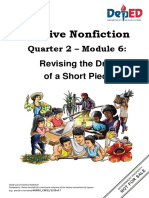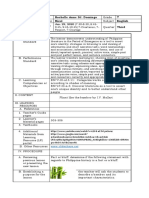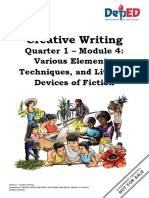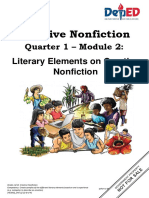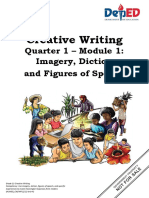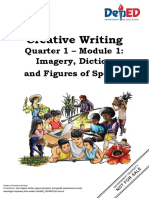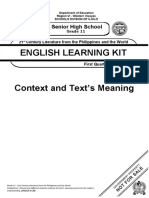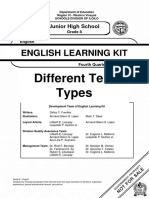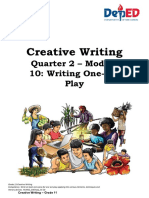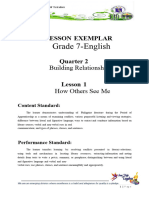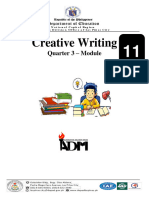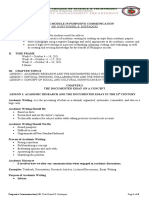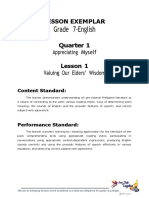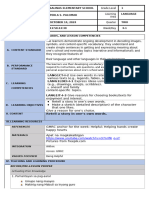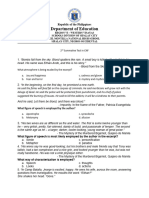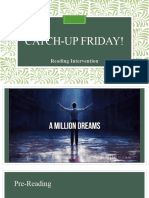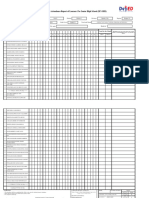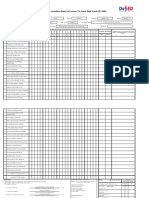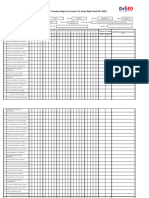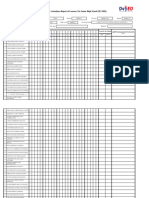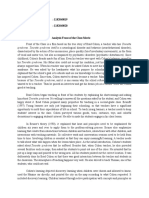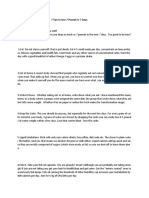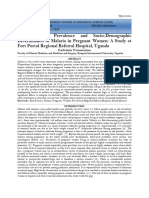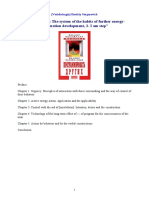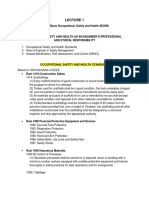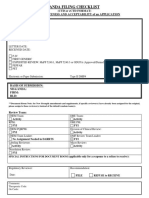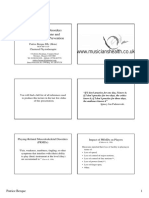CNF MELC7 FINAL Field-Validated
CNF MELC7 FINAL Field-Validated
Uploaded by
Lorgin nunialaCopyright:
Available Formats
CNF MELC7 FINAL Field-Validated
CNF MELC7 FINAL Field-Validated
Uploaded by
Lorgin nunialaOriginal Title
Copyright
Available Formats
Share this document
Did you find this document useful?
Is this content inappropriate?
Copyright:
Available Formats
CNF MELC7 FINAL Field-Validated
CNF MELC7 FINAL Field-Validated
Uploaded by
Lorgin nunialaCopyright:
Available Formats
11/12
Creative Nonfiction
Quarter 2 – Module 7:
Presenting a
Commentary/Critique
Grade 11/12-Creative Nonfiction 1
Competency: Present a commentary/critique on a chosen creative nonfictional text representing a particular type
or form (Biography/Autobiography, Literary Journalism/Reportage, Personal Narratives, Travelogue, Reflection
Essay, True Narratives, Blogs, Testimonies, Other Forms) (HUMSS_CNF11/12-IIb-c-17)
English – Grade 11/12
English Learning Kit
Presenting a Commentary / Critique
First Edition, 2020
Published in the Philippines
by the Department of Education
Schools Division of Iloilo
Luna Street, La Paz, Iloilo City
Republic Act 8293, section 176 states that: No copyright shall subsist in any work
of the Government of the Philippines. However, prior approval of the government agency
or office wherein the work is created shall be necessary for exploitation of such work for
profit. Such agency or office may, among other things, impose as a condition the payment
of royalties.
This English Learning Kit is developed by the Schools Division of Iloilo and to be
utilized by DepEd Region VI - Western Visayas.
ALL RIGHTS RESERVED. No part of this learning resource may be reproduced or
transmitted in any form or by any means electronic or mechanical without written
permission from DepEd - Region VI.
Development Team of English Learning Kit
Writers: Hizzle B. Paguntalan Julieto T. Montenegro, Jr.
Illustrators: Armand Glenn S. Lapor Mark T. Dasa
John Bermudo Joven Velasco
Layout Artists: Armand Glenn S. Lapor Ricky T. Salabe,
Jun Victor F. Bactan Sanil John S. Perez
Division Quality Assurance Team:
Lilibeth Larupay Armand Glenn S. Lapor
Ricky T. Salabe Dr. Ruby Therese P. Almencion
Sanil John S. Perez Ma. Jonalyn O. Gegato
Management Team: Ma. Gemma M. Ledesma Dr. Josilyn S. Solana
Dr. Elena P. Gonzaga Donald T. Genine,
Dr. Paul Nestor M. Pingil Dr. Roel F. Bermejo
Dr. Nordy D. Siason, Jr. Dr. Lilibeth T. Estoque
Dr. Azucena T. Falales Ruben S. Libutaque
Lilibeth E. Larupay Dr. Ruby Therese P. Almencion
Grade 11/12-Creative Nonfiction 2
Competency: Present a commentary/critique on a chosen creative nonfictional text representing a particular type
or form (Biography/Autobiography, Literary Journalism/Reportage, Personal Narratives, Travelogue, Reflection
Essay, True Narratives, Blogs, Testimonies, Other Forms) (HUMSS_CNF11/12-IIb-c-17)
Introductory Message
Welcome to Grade 11/12 Creative Nonfiction!
The English Learning Kit is a product of the collaborative efforts of the Division of
Iloilo Secondary English Teachers Association (DISETA) and the Division English
Coordinators Association (DECA) writers, illustrators, layout artists, reviewers, editors, and
Quality Assurance Team from the Department of Education, Schools Division of Iloilo. This
is developed to guide you dear learning facilitators in helping our learners meet the
standards set by the K to 12 Curriculum.
The English Learning Kit aims to guide our learners in accomplishing activities at
their own pace and time. This also aims to assist learners in developing and achieving the
lifelong learning skills while considering their needs and situations.
For the learning facilitator:
The English Learning Kit is developed to address the current needs of the learner
to continue learning in the comforts of their homes or learning centers. As the learning
facilitator, make sure that you give them clear instructions on how to study and accomplish
the given activities in the material. Learner’s progress must be monitored.
For the learner:
The English Learning Kit is developed to help you, dear learner, in your needs to
continue learning even if you are not in school. This learning material aims to primarily
provide you with meaningful and engaging activities for independent learning. Being an
active learner, carefully read and understand to follow the instructions given.
Grade 11/12-Creative Nonfiction 3
Competency: Present a commentary/critique on a chosen creative nonfictional text representing a particular type
or form (Biography/Autobiography, Literary Journalism/Reportage, Personal Narratives, Travelogue, Reflection
Essay, True Narratives, Blogs, Testimonies, Other Forms) (HUMSS_CNF11/12-IIb-c-17)
Presenting a Commentary/Critique
BEGIN
We are already more than halfway
through our entire learning experience. We
are almost getting to the finish line. For sure,
it has been an interesting exploration you
have gone through in the main thoroughfares
of the creative nonfiction. You have crossed
and grasped the boundaries between literary
arts and nonfiction which make it even more
interesting for you to take on another equally
challenging yet interesting writing task.
Hopefully, this will even help you
discover more about creative nonfiction and
its types. It is high time to be even more
critical of what was written and what you
read. It is time to write a
commentary/critique.
Let your imagination be your wings and
plunge yourself in the realm of creative
nonfiction!
TARGETS
At the end of this lesson, you should be able to:
1. Present a commentary/critique on a chosen creative nonfictional text
representing a particular type or form using a teacher-made nonfiction
commentary model. (HUMSS_CNF11/12-IIb-c-17)
Grade 11/12-Creative Nonfiction 4
Competency: Present a commentary/critique on a chosen creative nonfictional text representing a particular type
or form (Biography/Autobiography, Literary Journalism/Reportage, Personal Narratives, Travelogue, Reflection
Essay, True Narratives, Blogs, Testimonies, Other Forms) (HUMSS_CNF11/12-IIb-c-17)
TRY THIS
Activity 1
NONFICTIONAL TEXTS CAPTURED
Directions: Identify what is being described in each sentence. Choose your
answer from the types of nonfictional texts. Write your answers in your
activity notebook.
travelogue literary journalism autobiography
blog biography testimonio interview story
reflective essay character sketch descriptive essay
diary journal profile memoir
1. The writer constructs a true story about a time or period in his/her life, one that
had significant personal meaning and a universal truth. The writer composes the
story using the first person “I.”
2. It is short for web log which refers to an online diary that looks like a web page.
3. It is an old canon of Literature, dealing with nature writing, adventure writing,
exploration writing, guide books etc.
4. The writer composes his/her life story, from birth to the present, using the first
person “I.”
5. It uses technique of journalism (such as interviews and reviews) in order to look
outside of the straight forward, objective world that journalism creates.
6. It is an emerging form of creative nonfiction which refers to published oral or
written “first-hand accounts” which the witnesses wrote themselves, or dictated to
a transcriber.
7. It is an analytical practice of describing a real or imaginary scene, thoughts and
adding a personal reflection.
8. It gives a description about a particular topic, or describes the traits and
characteristics of something or a person.
9. It is a detailed description or account of a person’s life.
10. Like a pen-and-ink drawing, it acts as a cameo or miniature life story.
11. It is a kind of biographical narrative which focuses on a particular facet of the
featured person’s life as well as requires research and couple of interviews.
12. It is a quotidian or day to day record of the specific events that have transpired
in the life of its author and is ideally kept on a daily basis.
Grade 11/12-Creative Nonfiction 5
Competency: Present a commentary/critique on a chosen creative nonfictional text representing a particular type
or form (Biography/Autobiography, Literary Journalism/Reportage, Personal Narratives, Travelogue, Reflection
Essay, True Narratives, Blogs, Testimonies, Other Forms) (HUMSS_CNF11/12-IIb-c-17)
RECALL
When you were still in Grade 11 in your
Academic Reading and Writing subject, you
experienced writing an article critique. Let’s see
if you can still remember these terms which are
essential in writing a critique.
Activity 2
BRING BACK THE PAST
Directions: Column A contains statements which are related to writing a critique. Find
the terms referred or defined by these statements in Column B. Just write
the CAPITAL LETTER of your choice in your activity notebook.
A B
1. It is a critical challenge arguing for a
position other than that taken in the a. Introduction
focal article.
b. Style
2. It is the first paragraph, which is also
called “a gateway” of any text. c. Supporting
details
3. This part wraps up your text.
d. Commentary
4. It is a set of reasons given in order to
persuade. e. Literariness
.
5. They are additional facts used to f. Conclusion
explain and bolster an opinion, claim,
or belief. g. Argument
6. This makes the quality of the article to
be considered as creative work.
7. It refers to the “how” of a writer.
Grade 11/12-Creative Nonfiction 6
Competency: Present a commentary/critique on a chosen creative nonfictional text representing a particular type
or form (Biography/Autobiography, Literary Journalism/Reportage, Personal Narratives, Travelogue, Reflection
Essay, True Narratives, Blogs, Testimonies, Other Forms) (HUMSS_CNF11/12-IIb-c-17)
DO THIS
ACTIVITY 3
DIGGING A CRITIC’S BURROW
Directions: Read the article to be reviewed. Complete the details in the table that follow.
Write your answers in your activity notebook.
LEAVE THE KNOB CLOSE
By Julieto T. Montenegro, Jr.
No one has ever dared turn the knob open. Every family exactly knows what lies
beyond every door. For Nay Consoling and her family, their home is a safe place. They know
that once they break it open, they might have invited in carelessness and haste an
unforeseen stranger which may take their lives away.
For the last couple of months, the world remains in pursuit operation while the culprit
has continuously robbed many lives and left the rest of the living both restless and scared.
They shut their houses down for safety while the profile of the killer has been tracked down.
The killer is in the guise of a novel strain of corona-virus known as COVID-19 which
was first detected in December 2019 in Wuhan, China after an outbreak of pneumonia
without an obvious cause. Now the killer virus has shaken more than 200 territories across
the globe and was characterized as pandemic by the World Health Organization (WHO) in
March 2020.
Stranger it is. Even today, it is unclear where the virus has come from. It was only
understood to have originated in a food market in Wuhan and subsequently spread from
animal to human. Some research has claimed that the cross-species transmission may be
between snakes and human; however, even this claim has been refuted.
COVID-19 is found to be contagious. Increasing number of confirmed diagnoses,
including health care professionals, has indicated that person-to-person spread of the virus
is occurring. It is spread by respiratory droplets produced by infected persons when they
sneeze or cough.
As the virus strikes at the respiratory tract, common presenting symptoms include
fever and dry cough with some patients having sore throat, nasal congestion, malaise,
headache and myalgia or even breathing difficulty. In severe cases, COVID-19 can cause
pneumonia, severe acute respiratory syndrome, kidney failure and death.
While there is no reported vaccine yet to cure the infected, Nay Consoling takes
control of the matter in the family to avoid the spread of the virus and keep her family safe
from infection. The family starts a culture of washing their hands from time to time, coughing
into their elbows, and avoiding touching their faces, wearing of mask and observing social
distancing when going out.
But for the old matriarch, she better wants the family members to stay at home if
there is nothing much important to attend to outside, protect themselves from the strange
virus, and just leave as much as possible their doorknob close.
Grade 11/12-Creative Nonfiction 7
Competency: Present a commentary/critique on a chosen creative nonfictional text representing a particular type
or form (Biography/Autobiography, Literary Journalism/Reportage, Personal Narratives, Travelogue, Reflection
Essay, True Narratives, Blogs, Testimonies, Other Forms) (HUMSS_CNF11/12-IIb-c-17)
Article Author
Type of Creative Nonfiction
Topic
General Idea
Supporting Points
Target Output
Audience
Tone/Formality
EXPLORE
E
Amazing! You just have
accomplished the tasks with so much vigor.
Now, let’s explore more of the lesson by
answering the following questions. Write
your answers in your activity notebook.
1. How do you find the activity “Digging the Critic’s Burrow?”
2. What are your considerations in order to deduce the target output of the writer?
3. Why do you think it is important to identify the tone/formality of the text?
4. How can this activity develop your understanding of writing a critique of a
creative nonfictional text?
Grade 11/12-Creative Nonfiction 8
Competency: Present a commentary/critique on a chosen creative nonfictional text representing a particular type
or form (Biography/Autobiography, Literary Journalism/Reportage, Personal Narratives, Travelogue, Reflection
Essay, True Narratives, Blogs, Testimonies, Other Forms) (HUMSS_CNF11/12-IIb-c-17)
KEEP THIS IN MIND
Well done! You have successfully made
a meaningful connection after answering the
previous activities. Now, you are all set for the
discussion about writing a critique of creative
nonfictional text as well as familiarize yourself
of the common types of creative nonfictional
texts.
WHAT ARE THE TYPES OF CREATIVE NONFICTIONAL TEXTS?
As a major literary genre, creative nonfiction has also many literary types and
forms. It can be divided into three broad categories namely: biographical narratives,
autobiographical narratives, and various kinds of personal or informal essays (Aguila,
et.al, 2017). There are also special types which include travel, nature and food writing.
Recently new forms of creative nonfiction have emerged worldwide and these are
testimonio, the blog and Facebook status report.
Here are the definitions of the common forms of nonfictional texts:
1. Biographical narratives can be classified according to their length, scope,
amplitude into the full-length biography, profile, the character sketch and the
interview story.
a. Biography is the accurate representation of the life story from birth to
death of an individual written by one person for another person, along with
an effort to interpret the life so as to offer a realistic impression of the
subject.
b. Profile concentrates on a single aspect of the featured, city, institution, or
person’s life.
c. Character Sketch is shorter than a profile and can be described as
cameo or miniature life story.
d. Interview story zeroes in on one particular facet of the featured person’s
life and can be a product of meeting between a writer (interviewer) and his
or her subject (the interviewee).
Grade 11/12-Creative Nonfiction 9
Competency: Present a commentary/critique on a chosen creative nonfictional text representing a particular type
or form (Biography/Autobiography, Literary Journalism/Reportage, Personal Narratives, Travelogue, Reflection
Essay, True Narratives, Blogs, Testimonies, Other Forms) (HUMSS_CNF11/12-IIb-c-17)
2. Autobiographical narratives range from intimate writings made during life that were
not necessarily intended for publication (including letters, diaries, journals, memoirs,
and reminiscences) to the formal autobiography.
a. Autobiography is an account of one’s own life, generally a continuous
narrative of major events. The writer composes his/her life story, from birth
to the present, using the first person “I.”
b. Memoir -uses multiple scenes/stories as a way of examining a writer's life
(or an important moment in a writer's life). It can be written in a fragmentary
or dispersed style, like a mosaic or montage of small-scale narratives.
c. Diary - is a quotidian or day to day record of the specific events that have
transpired in the life of its author and is ideally kept on a daily basis.
d. Journal -contains personal details regarding impressions and opinions of
the journal writer concerning certain intriguing incidents or issues that have
come up and how specific persons have affected him/ her during course of
the day.
3. Personal or Informal Essays allows one to explore a topic through the lens of
his/her own, personal experiences, reflections, ideas, and reactions.
a. Literary Reportage/Journalism is a hybrid between responsible journalism
and imaginative literature uses the techniques of journalism (such as
interviews and reviews) in order to look outside of the straight forward,
objective world that journalism creates. It uses literary practices to capture
the scene/setting of the assignment or the persona of the person being
interviewed.
b. Descriptive essay represents the appearance or essence of something . It
gives a description about a particular topic, or describes the traits and
characteristics of something or a person
c. Reflective essay analyses the significance of a past event through serious
thought or consideration from the vantage point of the present. It is an
analytical practice of describing a real or imaginary scene, thoughts and
adding a personal reflection
4. Special types of creative nonfiction include travel writing, nature writing and food
writing. This can be illustrated in one form called as travelogue.
a. Travelogue is an old canon of literature, dealing with nature writing,
adventure writing, exploration writing, guide books etc. It includes the
Grade 11/12-Creative Nonfiction 10
Competency: Present a commentary/critique on a chosen creative nonfictional text representing a particular type
or form (Biography/Autobiography, Literary Journalism/Reportage, Personal Narratives, Travelogue, Reflection
Essay, True Narratives, Blogs, Testimonies, Other Forms) (HUMSS_CNF11/12-IIb-c-17)
narration of journey undertaken by the narrator from his/ her point of origin
to the eventual destination. It also entails detailed descriptions of the local
customs, and traditions, the landscape or cityscape, the native cuisine to
historical and cultural landmarks, and the sights and the sound the visited place
has to offer.
5. Emerging forms include Testimonio, Blog, and Facebook Status Report.
a. Testimonio refers to the published oral or written “first-hand accounts” which
the witnesses wrote themselves or dictated to a transcriber.
b. Blog, short for web log, is an online diary that looks like a web page. It is a
platform where a writer or a group of writers share their views on an
individual subject.
c. Facebook Status Report
WHAT IS A CRITIQUE?
A critique is a short paper, usually about one book or article. First, it gives a short
summary of what has been said in the article. Then, it looks at the article critically. In
presenting the critical comments, one has to look into the strengths and weaknesses of
the article. A critique can be positive or negative. However, it is better that the critique
points out to improving the article.
WHY WRITE A CRITIQUE?
A critique is written to judge the value of the piece. It is also looking into the content
and style of the writer. More so, a critique looks into other elements such as arguments
and insights that the reader as critique writer might agree or disagree.
HOW TO WRITE A CRITIQUE1?
1. Read the whole book or article thoroughly. Highlight text that you think important or
make notes as you go along. Re-read the article to make sure that your interpretation of
the author’s ideas and arguments are correct.
1
minah chugtai, “How to Write a Critique - Lecture Notes 7,” StuDocu, 2016,
https://www.studocu.com/row/document/comsats-university-islamabad/communication-skills/lecture-notes/how-
to-write-a-critique-lecture-notes-7/3159427/view.
Grade 11/12-Creative Nonfiction 11
Competency: Present a commentary/critique on a chosen creative nonfictional text representing a particular type
or form (Biography/Autobiography, Literary Journalism/Reportage, Personal Narratives, Travelogue, Reflection
Essay, True Narratives, Blogs, Testimonies, Other Forms) (HUMSS_CNF11/12-IIb-c-17)
2. Think carefully about what you have read and ask yourself questions about the article.
Look into the following:
2.1. What are the main points that the author is trying to make?
2.2. How does the author support those points? What evidences are being
presented?
3. Re-read material to make sure that you have understood the author’s ideas.
4. Try to summarize what you have read. You may wish to do this by way of bullet-
pointed notes. A spider diagram or mind map. Use whichever techniques suits you.
5. Think about different points of view:
2.1 How do the author’s ideas compare to other writers of the subject?
2.2 Do you agree or disagree with the author? You should say why. This might
mean backing up your own views with academic opinion, so you will need to
read around the subject area.
A CRITIQUE MAY FOLLOW THIS TEMPLATE
(A teacher-model template by Dr. Jesus C. Insilada)
1. Introduction. Presentation of the general ideas/points in the article.
Written by Beth Fennelly, I Survived the Blizzard of ’79 is her personal
account of which she was taking me to have a peek into her own experience
of the harsh blizzard. More than that, I believe, the personal narrative uses
the event itself - the blizzard - to describe the way her father was.
2. Presentation of the strengths and weaknesses of the article in terms of content,
arguments, evidences, and writing style.
Clearly, the story is loaded with symbolism which gave me a hard
time to understand initially. The images were becoming clearer as the
narration unfolds until I finally find the writing as something that could be
taken in different directions. The story mirrors issue on religion, trauma of a
tragedy, disassociation, and abuse among others. To me, it is very much
up to the readers’ interpretation.
Grade 11/12-Creative Nonfiction 12
Competency: Present a commentary/critique on a chosen creative nonfictional text representing a particular type
or form (Biography/Autobiography, Literary Journalism/Reportage, Personal Narratives, Travelogue, Reflection
Essay, True Narratives, Blogs, Testimonies, Other Forms) (HUMSS_CNF11/12-IIb-c-17)
3. Commentary on how you relate to the article. This may include the impact of the
article on your belief system and experiences as well as the effectiveness of the
author in presenting and supporting his arguments.
In the essay, Fennelly’s father insists on trekking the mile to Sunday
mass when the temperature is degrees below zero, something that at the
beginning I personally question. However, towards the end, I realized it was
an imagery of a father who attempted to protect his daughter with his scarf,
but allowing her to see death because of the blizzard and even a fight
between him and his wife.
I personally believe that the author succeeds at presenting the idea
why many people are afraid of becoming parents as it is the vital question
the story asks, when in fact parents know that eventually their children will
see the as flawed, just as they did to their parents who did it to their parents.
Both events in the story that I mentioned I believe have taken a child’s
innocence away which can be considered a painful process of growing up.
4. Looking into the literariness of the article. Literariness is the organization of
language which through special linguistic and formal properties distinguishes literary
texts from non-literary texts (Baldick 2008). In other words, literariness is the quality of
the article to be considered as creative work.
Fennelly’s personal narrative truly is interesting. Not only that it captures
significant human experience, but also the narrative reflects the author’s
creative side at displaying her skills at minimalism and images. Sentences
are broken as if it is a taste of poetry in prose. Sentences are read like
epigrams, giving a refreshing idea that the physical length of the narrative
and how it was written is a reminder that there is much more to be said
5. Conclusion. This includes your general take/comment on the article. This could be
the summary of your impressions on the technical and creative sides of the piece.
Finally, like any other essay of the author, this piece is a description of a
moment in a vivid detail with some scene left hanging for the readers to
think about and for him to visually experience. But for Fennelly, I am
quite certain that her painful experience of a blizzard – of her father -
creates memories she has lived to survive and share.
Grade 11/12-Creative Nonfiction 13
Competency: Present a commentary/critique on a chosen creative nonfictional text representing a particular type
or form (Biography/Autobiography, Literary Journalism/Reportage, Personal Narratives, Travelogue, Reflection
Essay, True Narratives, Blogs, Testimonies, Other Forms) (HUMSS_CNF11/12-IIb-c-17)
SUM UP
You are almost done with this
module. You have recognized the common
types of creative nonfictional text as well as
defined a critique and determined the steps
in writing it. Now, let’s recap important
things you have learned.
Creative nonfictional texts can be categorized into five broad categories namely (1)
biographical narratives, (2) autobiographical narratives, (3) personal or informal essays,
(4) special types, and (5) emerging new forms.
Biographical narratives include biography, profile, character sketch, and interview
story.
Autobiographical narratives include autobiography, memoir, diary, and journals.
Personal or informal essays can be descriptive or reflective in form.
Special types include travel writing, food writing, and nature writing. Travelogue can
be used to describe all these three forms.
Emerging new forms include testimonio, blog, and Facebook Status Report.
A critique is a short summary of what has been said in the article which includes
the discussion of the strengths and weaknesses of the article.as well as points out how to
improve the article.
In writing an article critique, one must observe the following steps namely: (1)
Read the whole book or article thoroughly and highlight text that you think important or
make notes as you go along; (2) think carefully about what you have read and ask
yourself questions about the article; (3) re-read material to make sure that you have
understood the author’s ideas; (4) try to summarize what you have read; and (5)Think
about different points of view
The critique can be written in five paragraphs: (1) introduction which presents the
general ideas/points in the article , (2) presentation of strengths and weaknesses n terms
of content, arguments, evidences, and writing style, (3) commentary on how you relate to
the article, (4) literariness or the quality of the article to be considered as creative work,
and (5) conclusion or the summary of your impressions on the technical and creative sides
of the piece.
Grade 11/12-Creative Nonfiction 14
Competency: Present a commentary/critique on a chosen creative nonfictional text representing a particular type
or form (Biography/Autobiography, Literary Journalism/Reportage, Personal Narratives, Travelogue, Reflection
Essay, True Narratives, Blogs, Testimonies, Other Forms) (HUMSS_CNF11/12-IIb-c-17)
Activity 4
LOOKING INTO THE EYES OF A BLIZZARD
Directions: Read the given sample article critique and pay attention to the structural
features. Use the graphic organizer Full House in answering the
questions below in your activity notebook.
A PEEK INTO HER STORY OF SURVIVAL FROM THE BLIZZARD
Written by Beth Fennelly, I Survived the Blizzard of ’79 is her personal account of
which she was taking me to have a peek into her own experience of the harsh blizzard.
More than that, I believe, the personal narrative uses the event itself - the blizzard - to
describe the way her father was.
Clearly, the story is loaded with symbolism which gave me a hard time to understand
initially. The images were becoming clearer as the narration unfolds until I finally find the
writing as something that could be taken in different directions. The story mirrors issues on
religion, trauma of a tragedy, disassociation, and abuse among others. To me, it is very
much up to the readers’ interpretation.
In the essay, Fennelly’s father insists on trekking the mile to Sunday mass when the
temperature is degrees below zero, something that at the beginning I personally question.
However, towards the end, I realized it was an imagery of a father who attempted to protect
his daughter with his scarf, but allowing her to see death because of the blizzard and even
a fight between him and his wife.
I personally believe that the author succeeds at presenting the idea why many people
are afraid of becoming parents as it is the vital question the story asks, when in fact parents
know that eventually their children will see the as flawed, just as they did to their parents
who did it to their parents. Both events in the story that I mentioned I believe have taken a
child’s innocence away which can be considered a painful process of growing up.
Fennelly’s personal narrative truly is interesting. Not only that it captures significant
human experience, the narrative also reflects the author’s creative side at displaying her
skills at minimalism and images. Sentences are broken as if it is a taste of poetry in prose.
Sentences are read like epigrams, giving a refreshing idea that the physical length of the
narrative and how it was written is a reminder that there is much more to be said.
Finally, like any other essay of the author, this piece is a description of a moment in
a vivid detail with some scene left hanging for the readers to think about and for him to
visually experience. But for Fennelly, I am quite certain that her painful experience of a
blizzard – of her father - creates memories she has lived to survive and share.
Grade 11/12-Creative Nonfiction 15
Competency: Present a commentary/critique on a chosen creative nonfictional text representing a particular type
or form (Biography/Autobiography, Literary Journalism/Reportage, Personal Narratives, Travelogue, Reflection
Essay, True Narratives, Blogs, Testimonies, Other Forms) (HUMSS_CNF11/12-IIb-c-17)
Directions: Use the graphic organizer Full House in answering the questions/statements
below in your activity notebook.
1. How does the article critique begin?
2. How is it structured?
3. What cohesive devices are used?
4. How are the supporting details presented? Are the explanations sufficient?
5. Describe the style and approach of presentation of ideas.
6. How is the conclusion organized?
Grade 11/12-Creative Nonfiction 16
Competency: Present a commentary/critique on a chosen creative nonfictional text representing a particular type
or form (Biography/Autobiography, Literary Journalism/Reportage, Personal Narratives, Travelogue, Reflection
Essay, True Narratives, Blogs, Testimonies, Other Forms) (HUMSS_CNF11/12-IIb-c-17)
REFLECT
REFLECT
Well done! You have shown great
improvement after accomplishing all the
tasks in each lesson. This time you will
reflect on your work and rate your
confidence.
Activity 5
TEMPERATURE CHECK
Directions: Accomplish the infographic. Write your answers in your CNF notebook.
How are you doing so far?
1 THING I REALLY DO NOT UNDERSTAND
Things I still do
2 THINGS I WANT TO ASK
3 THINGS I HAVE LEARNED
Grade 11/12-Creative Nonfiction 17
Competency: Present a commentary/critique on a chosen creative nonfictional text representing a particular type
or form (Biography/Autobiography, Literary Journalism/Reportage, Personal Narratives, Travelogue, Reflection
Essay, True Narratives, Blogs, Testimonies, Other Forms) (HUMSS_CNF11/12-IIb-c-17)
Activity 6
ONCE UPON A TIME IN A CRITIC’S WORLD
Directions: Write a critique of the given type of creative nonfictional text. Use the teacher-
model template in presenting your critique. Be guided by the given rubric for
article critique adapted from Academic Reading and Writing textbook.
BASKING ON A CHILLY PARADISE
A Travelogue by Addyvel Myles Aldon
The sun above the azure sky basked the whole city in a soft, warm yellow. The
light of the early morning beyond the window pane of our hotel room gave way to the
beautiful scenery that took our breath and sight--- colourful houses of varying stories
and lush green trees sat upon the towering mountains, giving Baguio the view that
could bring a person to his feet and murmur something in amazement.
I remember when we first set foot in the place. It greeted us with a chill. The cool,
gusting wind was like gentle fingers that soothed our skin. The trip to our hotel was far
different from what we encounter here in Iloilo, or in any place we have been for that
matter. One of the reasons is the long, winding roads that no taxi driver is afraid to take.
The pathways converge and diverge in highness and lowness, the curves seemed
endless and risky.
From then, pretty landscapes would fully steal our attention. We got to visit the
Burnham Park. In chilly mornings, the cacophony of highly optimistic people divided
into distinguishable groups were internally heartwarming. Yes, the park was awfully
nice like those pictures that I once saw on magazines and newspapers. I was engulfed
with the feeling of nostalgia and swarmed by childhood and happy memories upon
seeing the majestic playground and colorful benches under fruit-bearing trees and
above manicured grounds and bushes.
We also decided to see Baguio at night along the Harrison road. Of course, who
wouldn’t want to see the Night Market? It was foreign for me seeing the market vendors
just pulling out and prepping their goods at night. There were also large and small stalls
full of thrifty clothes and fruits and vegetables.
As promised, we further explored the depth of the friendly city. The Philippine
Military Academy was our first stop. Tall, green oaks and wide trees border the place,
giving the academy forest, cool, and natural vibe. Huge, decade-old canons and military
weapons dotted the polished and trimmed grass, perfect for picture-takings meant for
sharing on social media apps and tailored with meaningful captions. The buildings in
the academy spelt themselves clean-cut.
Grade 11/12-Creative Nonfiction 18
Competency: Present a commentary/critique on a chosen creative nonfictional text representing a particular type
or form (Biography/Autobiography, Literary Journalism/Reportage, Personal Narratives, Travelogue, Reflection
Essay, True Narratives, Blogs, Testimonies, Other Forms) (HUMSS_CNF11/12-IIb-c-17)
For some goodies and pictures to take back home, the Good Shepherd was
definitely a go-to. There was also this area where hanging plants and a good-looking
fountain stood, and a terrace overlooking a part of Baguio, with the city houses looking
like rainbow candies sitting atop high mountains.
After a quick trip to the Good Shepherd, we proceeded to the Mines View, where
a whole lot of nice things await our material-hungry beings. We ate corns in cobs and
cups, dipped in different sauces from butter to cheese. There were also horses
projecting really cutesy in different-colored ponytails and two, huge dogs that looked
real cuddly. There was an area wherein one could rent or buy an Igorot attire and take
pictures after for a fee. It is also in that place where we bargained and bought a lot of
products, from foods to souvenirs.
The ride in the bus was a cold one, similar but could never compare to the chill
brought about by the familiar breeze of the city. Glimpses of the last of the edges of
Baguio lingered on my sight, and I breathed a sigh. Even as we left the city, the
memories we made that featured the city of pines as the setting were priceless,
simply because, well, it’s a paradise under the azure sky with its warm sun always
ready to greet and welcome again its future guests
Rubric for Article Critique
Grade 11/12-Creative Nonfiction 19
Competency: Present a commentary/critique on a chosen creative nonfictional text representing a particular type
or form (Biography/Autobiography, Literary Journalism/Reportage, Personal Narratives, Travelogue, Reflection
Essay, True Narratives, Blogs, Testimonies, Other Forms) (HUMSS_CNF11/12-IIb-c-17)
GLOSSARY
Commentary -an analysis of the given passage, its function and its characteristics.
It should examine the key themes and stylistic devices of the
passage, showing how the language works to convey (or at times
undermine) its content.
Literariness - is the organization of language which through special linguistic and
formal properties distinguishes literary texts from non-literary texts.
The defining features of a literary work do not reside in extra-literary
conditions such as history or sociocultural phenomena under which
a literary text might have been created but in the form of the
language that is used. It is the feature that makes a given work a
literary work.
Grade 11/12-Creative Nonfiction 20
Competency: Present a commentary/critique on a chosen creative nonfictional text representing a particular type
or form (Biography/Autobiography, Literary Journalism/Reportage, Personal Narratives, Travelogue, Reflection
Essay, True Narratives, Blogs, Testimonies, Other Forms) (HUMSS_CNF11/12-IIb-c-17)
REFERENCES
Aguilla, Augusto Antonio, Galan, Ralph, and Wigley, John Jack. Telling the Truth: The Art
of Creative Nonfiction for Senior High School (2017). Quezon City: C & E
Publishing, Inc.pp 169-181
Barrot, Jessie. Academic reading and Writing for Senior High School (2016). Quezon
City: C & E Publishing, Inc.pp 169-181
chugtai, minah. “How to Write a Critique - Lecture Notes 7.” StuDocu, 2016.
https://www.studocu.com/row/document/comsats-university-
islamabad/communication-skills/lecture-notes/how-to-write-a-critique-lecture-notes-
7/3159427/view.
Coronavirus diseas (COVID-19): What parents should know I UNICEF I
https://www.unicef.org
Everything you should know about the coronavirus outbreak I the Pharmaceutical
Journal I Stewart, K., Connelly, D., Robinson, J. I July 13, 2020 I
https://educalingo.com/en/dic-en/literariness
https://penandthepad.com/five-common-forms-nonfiction-22536.html
http://thelatinoauthor.com/non-fiction/types/
https://www.pharmaceutical -jounral.com
https://www.uvm.edu/wid/writingcenter/tutortips/nonfiction.html
Grade 11/12-Creative Nonfiction 21
Competency: Present a commentary/critique on a chosen creative nonfictional text representing a particular type
or form (Biography/Autobiography, Literary Journalism/Reportage, Personal Narratives, Travelogue, Reflection
Essay, True Narratives, Blogs, Testimonies, Other Forms) (HUMSS_CNF11/12-IIb-c-17)
Activity 1
1. memoir
2. blog
3.travelogue
4.autobiography
5. literary journalism
6. testimonio
7. reflective essay
8.descriptive essay
9. biography
10. character sketch
11. interview story
12. diary
Activity 2
1. D 2. A 3. F 4. G 5. C 6. E 7. B
Activity 3
Answers vary
Explore
Answers vary
Activity 4
Answers vary
Activity 5
Answers vary
Activity 6
Answers vary
Grade 11/12-Creative Nonfiction 22
Competency: Present a commentary/critique on a chosen creative nonfictional text representing a particular type
or form (Biography/Autobiography, Literary Journalism/Reportage, Personal Narratives, Travelogue, Reflection
Essay, True Narratives, Blogs, Testimonies, Other Forms) (HUMSS_CNF11/12-IIb-c-17)
You might also like
- CNF Melc6 Final Field-ValidatedDocument15 pagesCNF Melc6 Final Field-ValidatedLawrence Mae CalaguingNo ratings yet
- Lesson Plan in English 7Document11 pagesLesson Plan in English 7jhames ancenoNo ratings yet
- Pliant Like The Bamboo DLLDocument3 pagesPliant Like The Bamboo DLLRochelle Anne DomingoNo ratings yet
- DLLP - Pliant Like A Bamboo REVISEDDocument13 pagesDLLP - Pliant Like A Bamboo REVISEDChristine Joy Guillano CalluengNo ratings yet
- Creating Your Financial GenogramDocument2 pagesCreating Your Financial Genogramdininja100% (1)
- CNF - MELC7.docx Q4 M1 Presenting Commentary CritiqueDocument22 pagesCNF - MELC7.docx Q4 M1 Presenting Commentary CritiqueHazel Joy CrizaldoNo ratings yet
- CNF MELC4 FINAL Field-ValidatedDocument32 pagesCNF MELC4 FINAL Field-ValidatedANGELIE CRISTINE POMADONo ratings yet
- Creative Nonfiction: Quarter 1 - Module 4Document36 pagesCreative Nonfiction: Quarter 1 - Module 4Jose Erwin Borbon100% (9)
- CNF Melc4 FinalDocument33 pagesCNF Melc4 FinalMae Sheilou Conserva Patero100% (1)
- CNF MELC5 FINAL Field-Validated-updatedDocument19 pagesCNF MELC5 FINAL Field-Validated-updatedNiña Patrice Martesano Selar100% (2)
- CW MELC4 LRv2Document39 pagesCW MELC4 LRv2Primerose GlnNo ratings yet
- Creative Nonfiction - Week 1Document23 pagesCreative Nonfiction - Week 1Mae Sheilou Conserva Patero100% (1)
- CW MELC4 LRv2Document38 pagesCW MELC4 LRv2Mary Kristelle DuranNo ratings yet
- CNF Melc2 Final Field-Validated-V2Document22 pagesCNF Melc2 Final Field-Validated-V2Wayne Dolorico MillamenaNo ratings yet
- CNF Melc1 Final Field-Validated-V3Document24 pagesCNF Melc1 Final Field-Validated-V3Wayne Dolorico MillamenaNo ratings yet
- Inbound 12144642660965758Document25 pagesInbound 12144642660965758katanaRosswellNo ratings yet
- CNF Melc9 FinalDocument24 pagesCNF Melc9 FinalLorgin nunialaNo ratings yet
- CNF Melc3 Final Field-ValidatedDocument32 pagesCNF Melc3 Final Field-ValidatedWayne Dolorico MillamenaNo ratings yet
- Week 1MATATAG QUARTER 2Document4 pagesWeek 1MATATAG QUARTER 2Roladel N.TupasNo ratings yet
- CW Melc8 FinalDocument20 pagesCW Melc8 FinalMarvelynFranciscoLagamoNo ratings yet
- CW Melc1 Lrv2Document30 pagesCW Melc1 Lrv2NoefeMohaganSalavanteNo ratings yet
- CW Melc1 Lrv2Document31 pagesCW Melc1 Lrv2NoefeMohaganSalavanteNo ratings yet
- 2nd Grading GRADE 9Document34 pages2nd Grading GRADE 9Fatima Butil100% (1)
- CW Module5 1Document26 pagesCW Module5 1almajojamNo ratings yet
- Creative Writing: Quarter 1 - Module 1: Imagery, Diction and Figures of SpeechDocument31 pagesCreative Writing: Quarter 1 - Module 1: Imagery, Diction and Figures of SpeechKristopher MartinNo ratings yet
- 21 ST Century Lit Week 4 NewformatDocument21 pages21 ST Century Lit Week 4 NewformatBENEDICT SERENONo ratings yet
- A. Types and Forms of Creative NonfictionDocument2 pagesA. Types and Forms of Creative NonfictionDaniella May Calleja100% (2)
- CW MELC3 LRv2Document27 pagesCW MELC3 LRv2Mary Kristelle DuranNo ratings yet
- Grade8 Q4 Melc5Document9 pagesGrade8 Q4 Melc5jhanceedebbieNo ratings yet
- DLL (CNF)Document6 pagesDLL (CNF)ricalyn belarminoNo ratings yet
- Maj 12 PresentationDocument38 pagesMaj 12 Presentationmajedz 24No ratings yet
- Week 1 - October 29, 30, 31Document8 pagesWeek 1 - October 29, 30, 31Josenia ConstantinoNo ratings yet
- Daily Lesson Log in English 7: Republic of The Philippines Division of Mandaue CityDocument2 pagesDaily Lesson Log in English 7: Republic of The Philippines Division of Mandaue CityTeacher MaryNo ratings yet
- CW Melc10-Finals q2Document19 pagesCW Melc10-Finals q2Frhea mae AlcaydeNo ratings yet
- g7 English Lesson Exemplar 2nd Quarterpdf PDF FreeDocument65 pagesg7 English Lesson Exemplar 2nd Quarterpdf PDF FreeFaith Marie UgasNo ratings yet
- English8 Week1Document16 pagesEnglish8 Week1JULIE ANNE TASICNo ratings yet
- English-7-LP-Q1-W2-D3-Basic Elements of PoetryDocument4 pagesEnglish-7-LP-Q1-W2-D3-Basic Elements of PoetryElvira InocNo ratings yet
- RWS Q3 Week 2 LAS 2 MELC 1.1Document11 pagesRWS Q3 Week 2 LAS 2 MELC 1.1jan anthony panchoNo ratings yet
- Canossa College Grade School Department S.Y. 2013-2014: Source: Philippine Elementary Learning CompetenciesDocument6 pagesCanossa College Grade School Department S.Y. 2013-2014: Source: Philippine Elementary Learning CompetenciesJensen MaghirangNo ratings yet
- Beowulf Day 1 To 3Document11 pagesBeowulf Day 1 To 3Angel NicoleNo ratings yet
- Inbound 8160041559631998402Document31 pagesInbound 8160041559631998402valladojhunloyd02No ratings yet
- 21 Century Literature From The Philippines and The World: Quarter 1Document34 pages21 Century Literature From The Philippines and The World: Quarter 1Kath Orbiso100% (2)
- EAP All Strands G11Document26 pagesEAP All Strands G11Al-var A AtibingNo ratings yet
- Week 910 11 Module in Purposive CommunicationDocument8 pagesWeek 910 11 Module in Purposive CommunicationJelaiza Thea FonteNo ratings yet
- Creative Writing Mod 4 q2Document24 pagesCreative Writing Mod 4 q2Naizene Heart OblioscaNo ratings yet
- 21st Century LiteratureDocument17 pages21st Century LiteratureBilly JoeNo ratings yet
- Lesson Plan in English Grammar - St. Paul FormatDocument4 pagesLesson Plan in English Grammar - St. Paul FormatVivian FlorendoNo ratings yet
- CW MELC2 LRv2Document26 pagesCW MELC2 LRv2Mary Kristelle DuranNo ratings yet
- Grade11LP (1) (AutoRecovered)Document6 pagesGrade11LP (1) (AutoRecovered)jasminsierra2000No ratings yet
- CW Melc1 Lrv2Document34 pagesCW Melc1 Lrv2Rina Jane Hingaray FloroNo ratings yet
- Elena Sulio - 21st Century Lit 2nd ModuleDocument7 pagesElena Sulio - 21st Century Lit 2nd ModuleMaria Elena ViadorNo ratings yet
- 21st Century Rethinking The Tower of BabelDocument2 pages21st Century Rethinking The Tower of Babelbea locsin100% (2)
- LP Print English 7 Quarter 4 Module Day 1Document3 pagesLP Print English 7 Quarter 4 Module Day 1Melonie TrongcosoNo ratings yet
- G7 English Lesson Exemplar 1st QuarterDocument89 pagesG7 English Lesson Exemplar 1st QuarterHanna CruzNo ratings yet
- Topic Content Standards Performance Standards Learning CompetenciesDocument6 pagesTopic Content Standards Performance Standards Learning CompetenciesKarla Bernadette LugtuHonrado GonzalesNo ratings yet
- DIV-WEEK5-Q2-for PrintingDocument8 pagesDIV-WEEK5-Q2-for PrintingRoselle Macaraeg-FloresNo ratings yet
- DLL Like The MolaveDocument7 pagesDLL Like The MolaveRencel HernandezNo ratings yet
- q2 DLP Language w4 d1Document4 pagesq2 DLP Language w4 d1Rochelle May CascoNo ratings yet
- Nonfiction Writing Strategies Using Content-Area Mentor TextsFrom EverandNonfiction Writing Strategies Using Content-Area Mentor TextsNo ratings yet
- Opening Doors to a Richer English Curriculum for Ages 10 to 13 (Opening Doors series)From EverandOpening Doors to a Richer English Curriculum for Ages 10 to 13 (Opening Doors series)No ratings yet
- 2nd SummativeDocument3 pages2nd SummativeLorgin nunialaNo ratings yet
- CNF Melc9 FinalDocument24 pagesCNF Melc9 FinalLorgin nunialaNo ratings yet
- DLL Catch Up Friday Week 4Document8 pagesDLL Catch Up Friday Week 4Lorgin nunialaNo ratings yet
- Catch Up Friday0202 IntegrationDocument26 pagesCatch Up Friday0202 IntegrationLorgin nunialaNo ratings yet
- 21 Century Literature: Welcome ToDocument23 pages21 Century Literature: Welcome ToLorgin nunialaNo ratings yet
- School Form 2 (SF 2)Document3 pagesSchool Form 2 (SF 2)Lorgin nunialaNo ratings yet
- DLL Catch Up Friday Week 6Document7 pagesDLL Catch Up Friday Week 6Lorgin nunialaNo ratings yet
- DLL Catch Up Friday Week 3.Document18 pagesDLL Catch Up Friday Week 3.Lorgin nunialaNo ratings yet
- School Form 2 (SF 2)Document3 pagesSchool Form 2 (SF 2)Lorgin nunialaNo ratings yet
- School Form 2 (SF 2)Document3 pagesSchool Form 2 (SF 2)Lorgin nunialaNo ratings yet
- catchUpFriday EnhancementDocument41 pagescatchUpFriday EnhancementLorgin nunialaNo ratings yet
- DLL Catch Up Friday Week 2Document15 pagesDLL Catch Up Friday Week 2Lorgin nunialaNo ratings yet
- DLL Catch Up Friday Week 7aDocument10 pagesDLL Catch Up Friday Week 7aLorgin nunialaNo ratings yet
- School Form 2 (SF 2)Document3 pagesSchool Form 2 (SF 2)Lorgin nunialaNo ratings yet
- Dll-Catch-Up-Friday-Week 9Document8 pagesDll-Catch-Up-Friday-Week 9Lorgin nunialaNo ratings yet
- catchUpFriday InterventionDocument41 pagescatchUpFriday InterventionLorgin nunialaNo ratings yet
- Catch Up Friday EnhancementDocument4 pagesCatch Up Friday EnhancementLorgin nunialaNo ratings yet
- Term-1 MCQ 3Document5 pagesTerm-1 MCQ 3Ansh KumarNo ratings yet
- Analysis Front of The Class Movie - Anita Dan Anitia - PBI 5ADocument2 pagesAnalysis Front of The Class Movie - Anita Dan Anitia - PBI 5AAnitazu 10No ratings yet
- 7 Pound in 7 DaysDocument2 pages7 Pound in 7 DaysEmmanuel CharlesNo ratings yet
- Susan Carlin Resume and Cover LetterDocument3 pagesSusan Carlin Resume and Cover LetterSusan CarlinNo ratings yet
- Understanding Leadership and Empowerment in The Workplace: Banutu-Gomez Michael BaDocument24 pagesUnderstanding Leadership and Empowerment in The Workplace: Banutu-Gomez Michael BalopmidNo ratings yet
- Assessing The Prevalence and Socio-Demographic Determinants of Malaria in Pregnant Women A Study at Fort Portal Regional Referral Hospital, UgandaDocument7 pagesAssessing The Prevalence and Socio-Demographic Determinants of Malaria in Pregnant Women A Study at Fort Portal Regional Referral Hospital, UgandaKIU PUBLICATION AND EXTENSIONNo ratings yet
- LESSON TITLE: Confidentiality and The Management of Health Care InformationDocument2 pagesLESSON TITLE: Confidentiality and The Management of Health Care InformationLovelie GuerroNo ratings yet
- Job Description Relationship Manager - InsuRx B2B2C (Multiple Locations)Document2 pagesJob Description Relationship Manager - InsuRx B2B2C (Multiple Locations)Sarvesh DubeyNo ratings yet
- Namkhai Norbu - On Birth and Life - A Treatise On Tibetan Medicine-Shang-Shung Edizioni (1983)Document58 pagesNamkhai Norbu - On Birth and Life - A Treatise On Tibetan Medicine-Shang-Shung Edizioni (1983)Marcos EstevamNo ratings yet
- Antibiotic, Pesticide, and Microbial Contaminants of Honey Human HealthDocument10 pagesAntibiotic, Pesticide, and Microbial Contaminants of Honey Human HealthJuan Alejandro JiménezNo ratings yet
- Livre Deir 3 - enDocument103 pagesLivre Deir 3 - ennepherNo ratings yet
- ME 317 Basic Occupational, Safety and Health (BOSH) : Based On OSH Standards of DOLEDocument7 pagesME 317 Basic Occupational, Safety and Health (BOSH) : Based On OSH Standards of DOLEAaron Choco De GuzmanNo ratings yet
- Breast UltrasoundDocument46 pagesBreast Ultrasoundg138182175% (4)
- Rueda ST., Calbayog City 6710 Website: HTTP//WWW - Nwssu.edu - PH Email: Telefax: (055) 2093657Document3 pagesRueda ST., Calbayog City 6710 Website: HTTP//WWW - Nwssu.edu - PH Email: Telefax: (055) 2093657Aya Jamel AsoqueNo ratings yet
- A98a00049een Precitest SolutionDocument2 pagesA98a00049een Precitest SolutionÀchraf IssaouiNo ratings yet
- Ject 52 247Document2 pagesJect 52 247ghg sddNo ratings yet
- MIA 22nd July 22Document17 pagesMIA 22nd July 22mn nandaniNo ratings yet
- EverGreen Pro 60-6 SDSDocument10 pagesEverGreen Pro 60-6 SDSKaustav MukherjeeNo ratings yet
- Lesson 19 - Childfree by ChoiceDocument7 pagesLesson 19 - Childfree by Choicegarciarjb000No ratings yet
- Review Article: Does Physical Activity Increase Life Expectancy? A Review of The LiteratureDocument10 pagesReview Article: Does Physical Activity Increase Life Expectancy? A Review of The LiteratureIbrahim HaidarNo ratings yet
- CHECKLIST Q3-2 2013b PDFDocument13 pagesCHECKLIST Q3-2 2013b PDFJoe Luis Villa MedinaNo ratings yet
- Derek Hansen-Applying Cocnepts of Signal and Noise To High Performance TrainingDocument77 pagesDerek Hansen-Applying Cocnepts of Signal and Noise To High Performance Trainingbobby100% (2)
- 5 Cases ReportDocument132 pages5 Cases ReportBilal PervaizNo ratings yet
- The Good Nurse 2022Document100 pagesThe Good Nurse 2022Tony EmmerNo ratings yet
- 15 - Chapter 5 PDFDocument62 pages15 - Chapter 5 PDFpraharshithaNo ratings yet
- 1ST Quarter Examination GRADE 12 P.E and HEALTHDocument2 pages1ST Quarter Examination GRADE 12 P.E and HEALTHRamon Villota67% (3)
- Musicians Mus Culo Skeletal DisordersDocument14 pagesMusicians Mus Culo Skeletal DisordersMariel Paz100% (1)
- Webinar Perawatan Luka Dan Tata Laksana Pemeriksaan InfeksiDocument41 pagesWebinar Perawatan Luka Dan Tata Laksana Pemeriksaan Infeksiqoote3No ratings yet
- WHO - Core Requirments - HafsahDocument53 pagesWHO - Core Requirments - Hafsahgul316991No ratings yet
